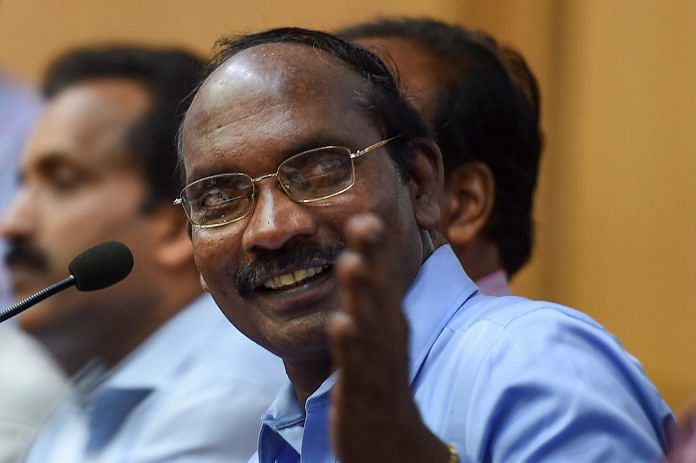Speaking at a press conference, ISRO chairman K. Sivan also said that he hoped women astronauts would be part of the human spaceflight programme.
Bengaluru: India’s second lunar mission Chandrayaan-2 will lift off around mid-April this year, a little later than originally planned, ISRO chairman K. Sivan announced Friday.
Addressing a press conference at the Indian Space Research Organisation (ISRO) headquarters in Bengaluru, Sivan said, “Due to some tests we couldn’t complete, the launch has been postponed to the next launch window and we are targeting for mid-April.”
He added that the date is not related to the general elections. ISRO had earlier said Chandrayaan-2 will be launched in the window between January and February this year.
The launch window will then open 25 March and stay open until the end of April. The subsequent launch window will open in June, but Sivan said they are confident of launching Chandrayaan–2 in mid-April.
Costing nearly Rs 800 crore, the mission is an advanced version of the previous Chandrayaan-1 mission about 10 years ago.
“We are landing in the South Pole, 74 degree south. All the past missions have landed near the equator, so we are expected lots of brand new science findings to happen as a part of this mission,” he said.
The launch and journey to the moon is expected to last 30 to 45 days during which six orbital raising manoeuvres will be performed. The mission’s orbiter is expected to last a year, while the lander and rover will last 14 days.
Also Read: ISRO sets target for 2019, plans 32 missions including Chandrayaan-2
Human spaceflight programme
Addressing the Gaganyaan mission, Sivan said a brand new centre called the Human Spaceflight Centre (HSC) has been established for the mission. Dr. Unnikrishnan Nair, the director of Vikram Sarabhai Space Centre, will head the centre while its project director will be R. Hutton, who is currently the project director for the PSLV program.
The maiden human spaceflight is expected to occur in December 2021, ahead of the 2022 deadline set by Prime Minister Narendra Modi.
“Gaganyaan is of high priority in 2019. All of ISRO is focused on making this work and the Centre has begun work in full steam,” Sivan said.
He also added he would definitely like women to be among the first group of Indian astronauts being sent to space, but the final group will depend on who passes the selection committee.
Future missions
Among other interplanetary missions, Sivan said that the first upcoming mission will be Aditya L1, which will study the sun and heliophysics. The next mission will be an orbiter to Venus, dubbed ‘Shukrayaan’ in the media, for which a call for proposals has been put out already.
“The Venus mission will be defined and announced after a couple of months,” he said. “The mission itself will launch in 2023 or after.”
ISRO is also in talks about a prospective successor to the Mars Orbiter Mission.
Sivan said that the current year will see double the number of missions: 32. Of these, 14 will be launch vehicle missions (8 PSLV, 2 GSLV, 2 GSLV Mk3, 2 SSLV) and 18 spacecraft.
The immediate next launch is the PSLV mission C44.
During September-October, GSAT 20 will be launched as a part of the government’s Digital India Programme. “Along with the existing GSAT 11 and 20, this will provide high bandwidth connectivity to all of India,” said Sivan.
The Small Satellite Launch Vehicle (SSLV), which takes only 72 hours to assemble and six people to operate, will perform its maiden flight in July, said Sivan. It can carry payloads up to 500kg to space and will be an on-demand vehicle.
Sivan also announced more details about the reusable launch vehicle, without giving too many details. The demo of the vehicle is expected to take place this year. It will be carried by a helicopter and released in sky, and will land on a test runway without piloting.
Also Read: ISRO successfully launches satellite meant to boost IAF communication systems



